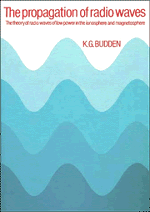 The Propagation of Radio Waves
The Propagation of Radio Waves Book contents
- Frontmatter
- Contents
- Preface
- 1 The ionosphere and magnetosphere
- 2 The basic equations
- 3 The constitutive relations
- 4 Magnetoionic theory 1. Polarisation and refractive index
- 5 Magnetoionic theory 2. Rays and group velocity
- 6 Stratified media. The Booker quartic
- 7 Slowly varying medium. The W.K.B. solutions
- 8 The Airy integral function and the Stokes phenomenon
- 9 Integration by steepest descents
- 10 Ray tracing in a loss-free stratified medium
- 11 Reflection and transmission coefficients
- 12 Ray theory results for isotropic ionosphere
- 13 Ray theory results for anisotropic plasmas
- 14 General ray tracing
- 15 Full wave solutions for isotropic ionosphere
- 16 Coupled wave equations
- 17 Coalescence of coupling points
- 18 Full wave methods for anisotropic stratified media
- 19 Applications of full wave methods
- Answers to problems
- Bibliography
- Index of definitions of the more important symbols
- Subject and name index
10 - Ray tracing in a loss-free stratified medium
Published online by Cambridge University Press: 06 December 2010
- Frontmatter
- Contents
- Preface
- 1 The ionosphere and magnetosphere
- 2 The basic equations
- 3 The constitutive relations
- 4 Magnetoionic theory 1. Polarisation and refractive index
- 5 Magnetoionic theory 2. Rays and group velocity
- 6 Stratified media. The Booker quartic
- 7 Slowly varying medium. The W.K.B. solutions
- 8 The Airy integral function and the Stokes phenomenon
- 9 Integration by steepest descents
- 10 Ray tracing in a loss-free stratified medium
- 11 Reflection and transmission coefficients
- 12 Ray theory results for isotropic ionosphere
- 13 Ray theory results for anisotropic plasmas
- 14 General ray tracing
- 15 Full wave solutions for isotropic ionosphere
- 16 Coupled wave equations
- 17 Coalescence of coupling points
- 18 Full wave methods for anisotropic stratified media
- 19 Applications of full wave methods
- Answers to problems
- Bibliography
- Index of definitions of the more important symbols
- Subject and name index
Summary
Introduction
The term ‘ray’ was used in § 5.3 when discussing the field of a radio wave that travels out from a source of small dimensions at the origin of coordinates ξ, η, ζ in a homogeneous medium. The field was expressed as an integral (5.29) representing an angular spectrum of plane waves. The main contribution to the integral was from ‘predominant’ values of the components nξ, nη of the refractive index vector n such that the phase of the integrand was stationary for small variations δnζ, δnη For any point ξ, η, ζ there were one or more predominant values of the refractive index vector n, such that the line from the origin to ξ, η, ζ was normal to the refractive index surface. Each predominant n defines a progressive plane wave that travels through the whole of the homogeneous medium.
Instead of selecting a point ξ, η, ζ and finding the predominant ns, let ns choose a fixed n and find the locus of points ξ, η, ζ for which this n is predominant. For a homogeneous medium this locus is called the ‘ray’. The arguments leading to (5.31) still apply and show that it is the straight line through the origin, in a direction normal to the refractive index surface at the point given by the chosen n.
- Type
- Chapter
- Information
- The Propagation of Radio WavesThe Theory of Radio Waves of Low Power in the Ionosphere and Magnetosphere, pp. 254 - 294Publisher: Cambridge University PressPrint publication year: 1985
